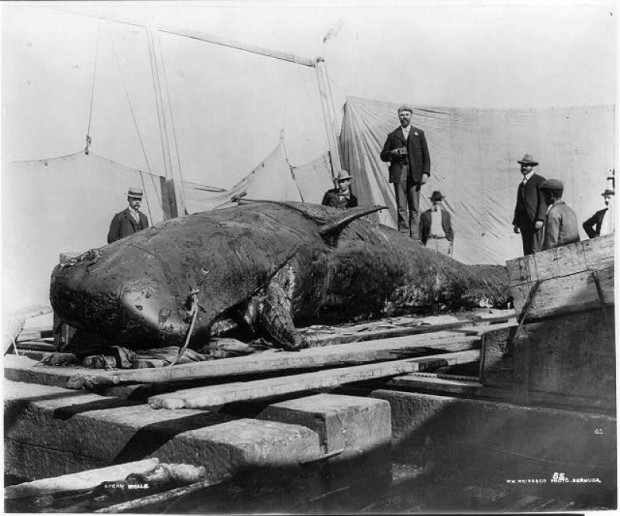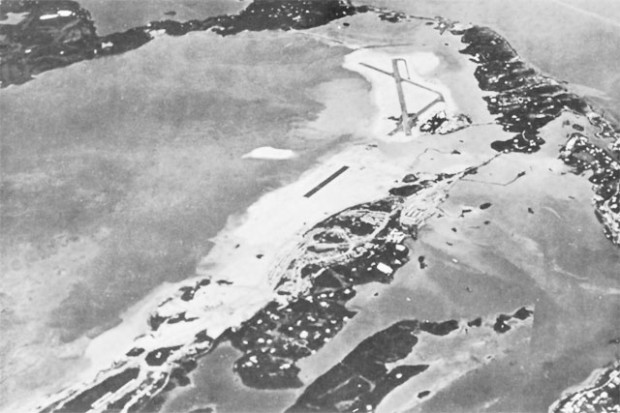Tommy Fox: St. David’s Uncrowned King
 He was known as “King Tommy” — the uncrowned King of St. David’s Island — and once decided to establish the veracity of the Biblical story of Jonah by demonstrating it was possible for a man to crawl into the stomach of a whale.
He was known as “King Tommy” — the uncrowned King of St. David’s Island — and once decided to establish the veracity of the Biblical story of Jonah by demonstrating it was possible for a man to crawl into the stomach of a whale.
Henry Mortimer [Tommy] Fox [1860-1942] was a whaler, fisherman and renowned authority on hurricanes, preferring to consult his shark oil barometer even after modern meteorological station was established in Bermuda during the 1930s.
“Every Bermudian and a host of Americans knew and loved Tommy Fox,” the “New York Times” said in obituary of the legendary St. David’s Islander which ran a few days after his death in October, 1942. “Tommy was tall as a ship’s spar; his skin, burned with the suns of eighty-one summers, was like tanned leather; he carried himself with kingly dignity …”
Always a seasonal and relatively minor industry, whaling fell into decline in Bermuda after kerosene began to replace whale oil for use in lanterns in 1860.
By 1880 Tommy Fox’s 28-foot “Shamrock”, equipped with a whale gun and a hundred feet of line, was one of only four vessels still hunting the great mammals in local waters.
According to research conducted by American academic Dr. Aldemaro Romero, after the introduction of kerosene only seven more whales were captured off Bermuda for the remainder of the 19th century — three of them by Tommy Fox’s “Shamrock.”
The last was a captured on December 11, 1894 — a 56-foot sperm whale killed 14 miles off the island and then towed to Southampton Bay. The animal yielded 60 barrels of oil valued at £260.
The son of a pilot, although Tommy Fox used to say he had “saltwater running through my veins instead of blood”, he had retired from seafaring by 1910.
Investing the not inconsiderable fortune he had made from whaling and fishing in St. David’s real estate, he turned to farming at a time when large swathes of the island were given over to the cultivation of Easter lilies.
Baby Sperm Whale Harpooned And Landed In Bermuda, Late 19th Century
By the 1930s, the plain-spoken and colourful former seafarer was something of a local hero.
He was sought out by visiting celebrities including Oscar-winning actor Frederic March — who offered to take him to Hollywood after they spent a day fishing together off St. David’s — and American journalists, who sat spellbound as he recounted 19th century sea yarns on the porch of his home overlooking Castle Harbour.
“Tommy Fox looks much younger than his 76 years,” said a 1936 syndicated profile which ran in American newspapers. “Six foot three and straight as an arrow, it is difficult to believe that Tommy harpooned his first whale 58 years ago in 1878.
“In those days Bermuda sailors were much sought after by the New England skippers in search of crew members. The Bermuda plan of sighting a school of whales from shore and going after them in a whale boat was a hazardous though remunerative procedure …”
Then, during the twilight of Tommy Fox’s life, he found himself courted by Bermudian politician, Government House and British and American diplomats when it was announced the UK had agreed to let the US build a major military base in secluded St. David’s in 1940.
The East End base and a separate facility in Southampton had been included as an addendum to the US-UK Destroyers For Bases deal between British Prime Minister Winston Churchill and US President Franklin D. Roosevelt in September, 1940. Considered vital to trans-Atlantic shipping, aviation and to coordinating action against Nazi submarines in the Battle of the Atlantic, an enemy attack on Bermuda could not be discounted.
The deal allowed Britain to hand much of the defence of Bermuda over to the still-neutral US, freeing British forces for redeployment to more active wartime theatres. It also enabled the development of strategic facilities at US expense which British forces would also utilise.
Tommy Fox’s assent to the base project was considered essential by all parties involved — and it was quickly forthcoming.
“Changes affecting both the homes and economic way of life of hundreds of Bermudians are following in the wake of Uncle Sam’s acquisition of naval and air bases in these islands,” read a 1941 American newspaper report. ” … The St. David’s Islanders are affected principally, for 300 of the 450 acres which make up that island are to be turned over to the United States.
“St. David’s Islanders are unique in their way of life. Many of them have never crossed the narrow strip of water which separates them from the former capital of St. George’s.
“When the Severn Bridge was dropped across St. George’s harbour some years ago, many crossed to view St. George’s for the first time. But a greater number have not yet seen what they rest of Bermuda looks like.”
St. David’s Islanders had for the most part been content to maintain their almost 350-year splendid isolation from the rest of Bermuda despite the advent of a bridge in the 1930s.
Bermudian, US and UK officials were all aware news of the base deal — which would involve 250 people out of a total population of 475 being uprooted and required to move — could have been met with resistance.
“A meeting was held in St. David’s the day after the announcement about the base sites was made in the colony’s House of Assembly,” continued the American newspaper report. “It might have been expected that the meeting would express indignation, but the Pequot Indian blood in the St. David’s Islanders kept them silent …
“They accepted the announcement with no murmur of protest. They did more than that. At the instigation of S. Seward Toddings, one of their representatives in the House of Assembly, they adopted a resolution declaring that they wished to express their ‘loyalty to the British Empire by accepting the sacrifices in the spirit of support for ultimately winning the war against Germany and Italy’ …”
Tommy Fox lost much of the acreage he owned in St. David’s to the Americans and the compensation he received was unlikely to have made up for the emotional trauma of leaving the only home he had known for all of his 80 years.
But he was the first to give his support to the declaration of loyalty — and with his blessing, his fellow St. David’s Islanders fell in behind him.
“Some people don’t believe that a whale could have swallowed Jonah,” Tommy Fox — a devout Christian and senior St. David’s churchwarden — told an interviewer in 1935. “So I decided to prove to them that the Bible was correct. The very next time I landed a whale, I hauled up his head, opened his mouth, and in the presence of witnesses I climbed down that whale’s throat into his belly!”
That feat earned his the nickname “The Second Jonah” in some quarters. His selflessness when it came to handing over his land to the American military during World War Two earned him yet another soubriquet — “The Second Solomon” – for both the courage and wisdom involved.
Aerial View Of St. David’s After Work Commenced On Kindley Field & The American Military Base
Read More About
Comments (10)
Trackback URL | Comments RSS Feed
Articles that link to this one:
- Bermuda Factored In 1942 US Invasion Scenario | Bernews.com | February 16, 2013
- Bermuda Historical Society Launches New Book | Bernews.com | March 17, 2013




cool!
Funny how the St. David’s Islander community took the bitter pill of absolute support for the Crown, but in the end, lost their homes, their farms, and their easy access to the ocean from the lea of South Side!
The reference to North American Indian blood has more of significance than first glance. One great American Chief said: “The white men made us many promises, but they only kept one, they promised to take our land and they took it! Too bad ‘Chief’ Tommy and the rest of St. David’s Islanders did not insisted on a reclaim to our ancestral lands when the US pulled out.
For the record, not all prominent St. David’s Islanders were so cooperative; my great Grandfather Red Benny Lamb was one such islander who had no time for the Yanks taking our lands.
Look at St. David’s today? The US gave back the land, and instead of it being distributed to the descendants’ of all the former land owners, St. David’s Islanders are losing their lands once again, and for a similar reason: political expediency.
Well said Cousin Randy. Those of us who are SDI’s know this story only too well. We have told it over and over but it only falls on deaf ears. To all the SDI’s who have lost their ancestral land, stand up and speak out!
wonder how or if uncle tommy was named after this guy were they related wae this person elated to macsweeny, roy or granville fox
Speak out for what? That you want it back your land back? Sorry buddy you be getting back what I purchased…
Great article, and good point Randy.
Ditto on Great Grand Pa Red Benny too, as we know he refused to go, so they carried him out on his bed and a excavating machine then demolished his house, he was the last St David’s Islander to leave I believe. I agree, it is a shame that a caveat wasn’t added at the time of the hand over for when the US eventually vacated the land, no doubt another example of how people who where largely ill educated where taken advantage of.
As Uncle Ira ‘Jethro’ Pitcher would always say, “we where moved off our land and onto the ‘Reservation’ again, just like our ancestors in the US”. The more things change the more they stay the same.
@ CheapSkate, no one is demanding or expecting that you or others who have now legally purchased property be removed or forced to ‘give it up’. Especially as there are still tracts of land that could still be sold/transferred to St David’s Islanders at a fair price at least.
I do agree, with all that have been said, we should have got our land back. i know and you all know, those of the islander didn’t like us. they were alway jealous of our people and the way we lived. I PROUD OF MY PEOPLE.
I still have photos of Blackwolff and Ivan playing on the beach across from clearwater beach. Harry G’s stake was near Ruth’s Bay. What a prize that would capture today. Still he could only look at it from the lot he got at the bottom of Texas Road. I’ve heard it said that giving back the land would equate to the US giving back the land to the displaced Indians..but that’s a dream and the price of war!